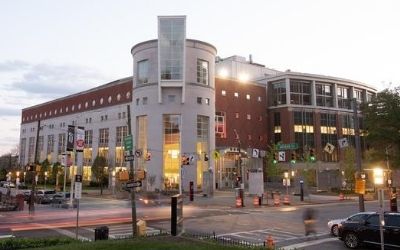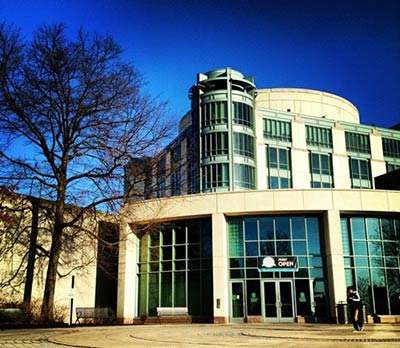Resources
With joint appointments between UMSOM and UMBC, all UM FIRST recruits will have access to cutting-edge, state-of-the-art resources available on both campuses.
Center for Innovative Biomedical Resources (CIBR)
The Center for Innovative Biomedical Resources (CIBR) is a novel center that provides infrastructure and oversight for a collection of 35 scientific cores that provide state-of-the-art technologies, high-tech instrumentation, and expertise that supports biomedical research, clinical practice, and healthcare in the state of Maryland and the region. Each core facility within CIBR is overseen by a PhD-level director and includes highly trained technical staff who can support investigators by training users, and assisting in experimental design, data analysis, and interpretation. Training is provided for all graduate and medical students, postdoctoral fellows, and faculty within the university as well as outside collaborators.
Included within the resources in CIBR are animal model resources; bioinformatics and statistics cores; cytometric and bioassay cores that include flow cytometry, cytokine analysis, and mass cytometry; drug development resources including pharmacokinetics, x-ray crystallography, NMR, CryoEM, etc.; imaging cores including MRI, confocal microscopy, scanning and transmission electron microscopy, Xenogen; nucleic acid & genomics resources, and much more.
UMBC Core Facilities
UMBC provides easy access to a variety of shared core facilities with cutting edge technologies and expertise. Available resources include the Aquaculture Research Center (ARC), Functional Magnetic Resonance Imaging, a Glasswork Facility, a High Performance Computing Fcility, the Keith R. Porter Core Imaging Facility, the Molecular Characterization and Analysis Complex, a Photogrammetry Facility, and the Pi Squared Visualization Facility.
UMB Institute for Clinical & Translational Research (ICTR)
The UMB Institute for Clinical and Translational Research (ICTR) is a clinical and translational research initiative that is supported by the UMB campus and funded by an NIH CTSA grant in collaboration with Johns Hopkins University. ICTR provides financial support, infrastructure, environment, training, and workforce to invigorate, facilitate, and accelerate clinical translational research to improve patient and community health.
ICTR provides substantial resources to support clinical and translational research, including core services, education and training opportunities and grants, and community engagement with local health providers, community-based organizations, disease advocacy groups, nonprofit or industry entities engaged in translational research, and other local or national communities. ICTR resources will be available to all UM FIRST recruits.
UMB Health Sciences and Human Services Library (HSHSL)

The UMB Health Sciences and Human Services Library was the first library established by a medical school in the United States. The library currently provides access to more than 108 databases, 17,400 ebook titles, and 360,000 print volumes, in addition to numerous subscriptions. The library is staffed by 25 faculty librarians and more than 50 full-time personnel.
In addition to the print collection and journal holdings, the library offers:
- publicly available computers
- fully equipped classrooms
- video conference rooms
- group study rooms
- a Bioinformation and Data Science computer
- a presentation practice studio with video recording and editing equipment
- a collaborative learning room
- an innovation space with 3D printing equipment and design software
UMBC Albin O. Kuhn Library and Gallery

The UMBC Albin O. Kuhn Library and Gallery holds more than 650,000 monographs and subscriptions number over 4,000. In addition to the holdings, UMBC has access to the book catalogs of 10 other campuses in the University of Maryland System (UMMS) and has reciprocal interlibrary loan arrangements with several other strong science-oriented collections in the region, including The Johns Hopkins University.
In addition to these holdings, the library also offers:
- virtual study space
- group and individual study rooms
- a learning center
- a lactation room
- a presentation practice room with a recording system
- a digital media lab
- a screening room
- assistive technology rooms
- faculty study rooms
- numerous computers available for general use
Learn more about the UMBC Library
Keith Porter Imaging Facility

Mouse hippocampus neurons. M. Bryley, LeGates lab
The Keith R. Porter Imaging Facility of the College of Natural and Mathematical Sciences at UMBC provides core instrumentation for biological and materials science research. Equipment and services are available to all faculty and staff at UMBC, as well as the surrounding academic and industrial communities. Instruments are in Biological Sciences and Physics buildings, and the Interdisciplinary Life Sciences Building where all aspects of imaging, protocol development, sample preparation, and equipment training and image processing are supported.
The Molecular Characterization and Analysis Complex (MCAC)
The Molecular Characterization and Analysis Complex (MCAC) of the College of Natural and Mathematical Sciences at UMBC is dedicated to developing cutting edge analytical techniques to solve modern problems while providing a stimulating learning environment and exposure to research for both undergraduate and graduate students. Open to universities and all other facilities in need of analytical techniques, the MCAC strives to be an environment of peer mentoring, professional team building, and a place to develop critical thinking skills by fusing academic research with both teaching and industry. The MCAC provides a vast array of instrumentation for mass spectrometry, NMR, and FT-IR, and a wide variety of other instrumental techniques for the analysis of compounds. This facility includes a dedicated full time Facility Manager for consultation, as well as other knowledgeable staff, allowing the MCAC to analyze almost any compound quickly and easily, with accurate results. The center allows researchers to submit samples for analysis or to be trained to use the instruments. The facility houses a suite of liquid chromatography systems, including a Dionex ICS-2100 ion chromatography system with conductivity detection, a Dionex ICS 5000 anion chromatography system with UV-Vis detection, a Dionex DS-600 System with electrochemical detection, a Dionex UltiMate 3000 system with variable wavelength detection, and a PerkinElmer Flexar FX-15 UHPLC. The facility also has several mass spectrometry instruments including a Bruker 12T Apex IV Fourier Transform Ion Cyclotron Resonance Mass Spectrometry (FT-ICR-MS), a Bruker Autoflex Time of Flight (TOF) mass spectrometer coupled with Matrix Assisted Laser Desorption Ionization (MALDI), a Bruker Amazon Speed Ion Trap (ASIP), a PerkinElmer Axion Time of Flight (TOF) coupled with a Direct Source Analysis (DSA), a PerkinElmer Clarus 600 GC-MS, a PerkinElmer NexION 300D quad mass spectrometer coupled with Inductively Couple Plasma (ICP) ionization, and a Thermo Scientific Liner Trap Quadropole (LTQ) XL ion trap. The facility also has the capability to perform NMR, with JEOL 400 MHz NMR and Bruker 500 MHz with Cryoplatform NMR platforms. Finally, the facility has several spectroscopy options, including a PerkinElmer Frontier Optica FT-IR, a Jasco V-560 UV-Vis spectrophotometer with temperature control capabilities, and a JY-Horiba FluroMax 3 fluorometer.
High Performance Computing Facility (HPCF)
The High Performance Computing Facility is the community-based, interdisciplinary core facility for scientific computing and research on parallel algorithms at UMBC. Since HPCF’s inception in 2008, over 400 users have benefited from its computing clusters, including undergraduate and graduate students. The users generated over 400 publications, including 150 papers in peer-reviewed journals (including Nature, Science, and other top-tier journals in their fields), 50 refereed conference papers, and 50 theses. The facility is open to UMBC researchers at no charge. System administration is provided by the UMBC Division of Information Technology, and users have access to consulting support provided by dedicated full-time graduate assistants. The purchase of the two current clusters taki and ada were supported by several NSF grants from the MRI programs.
